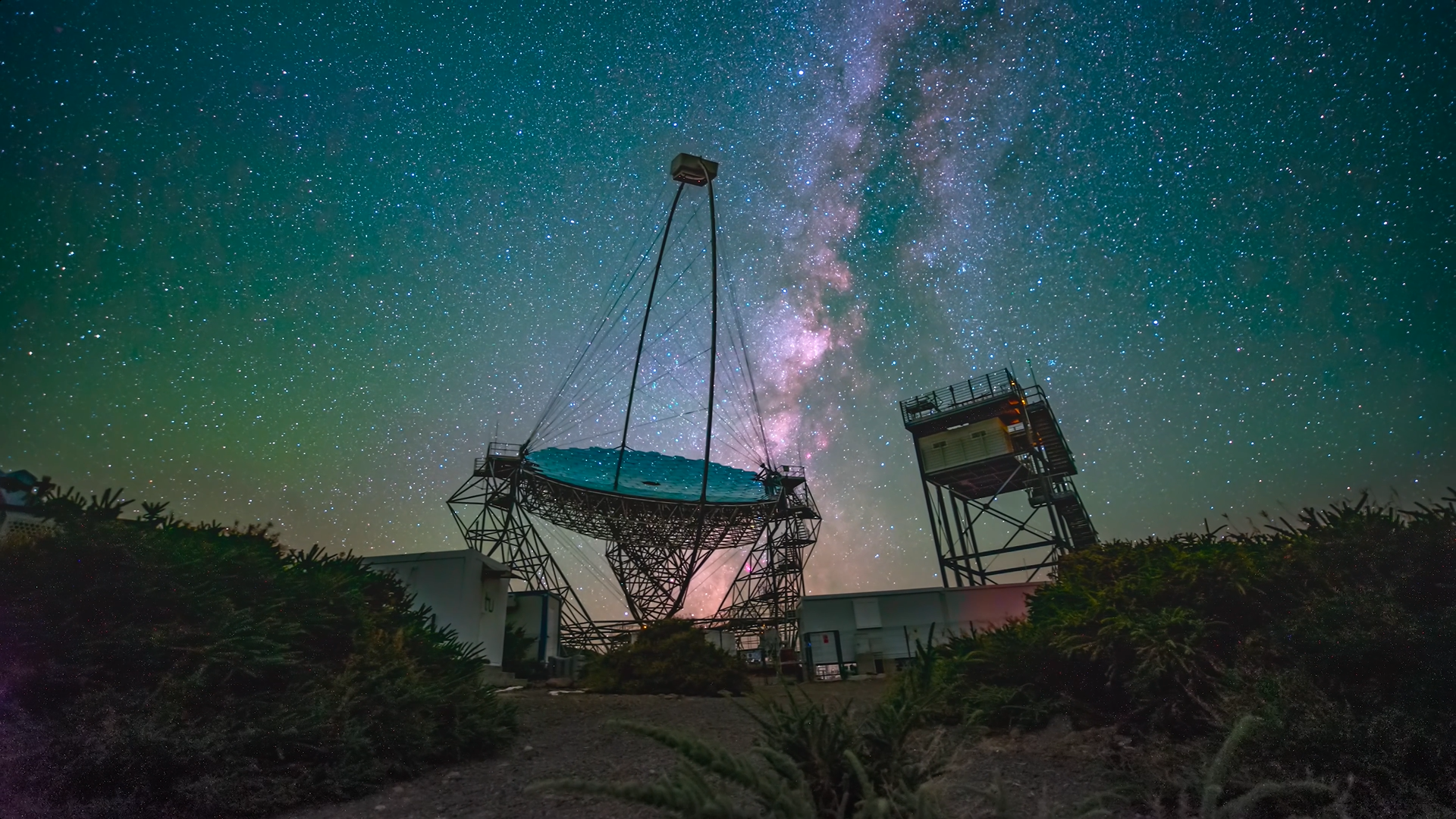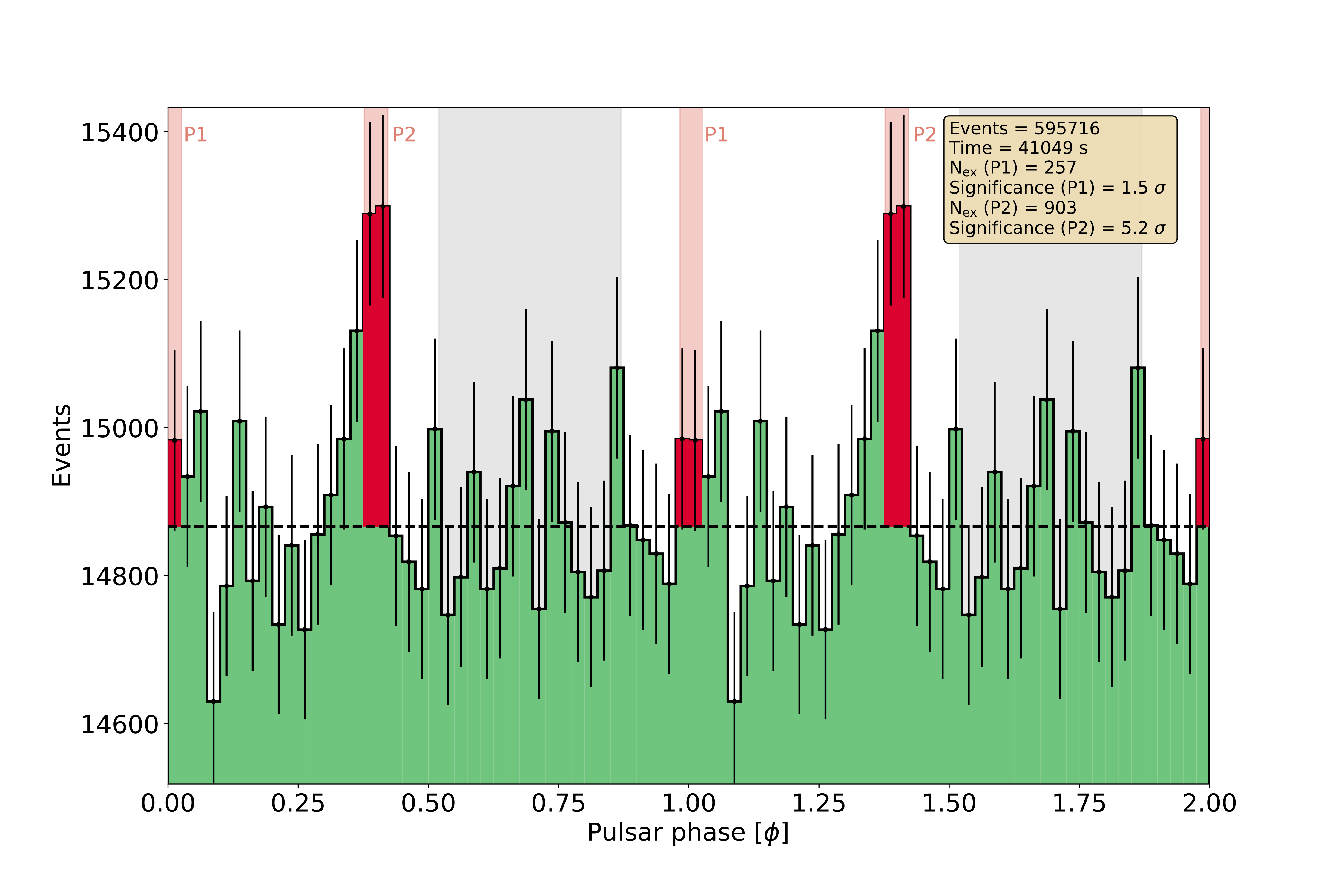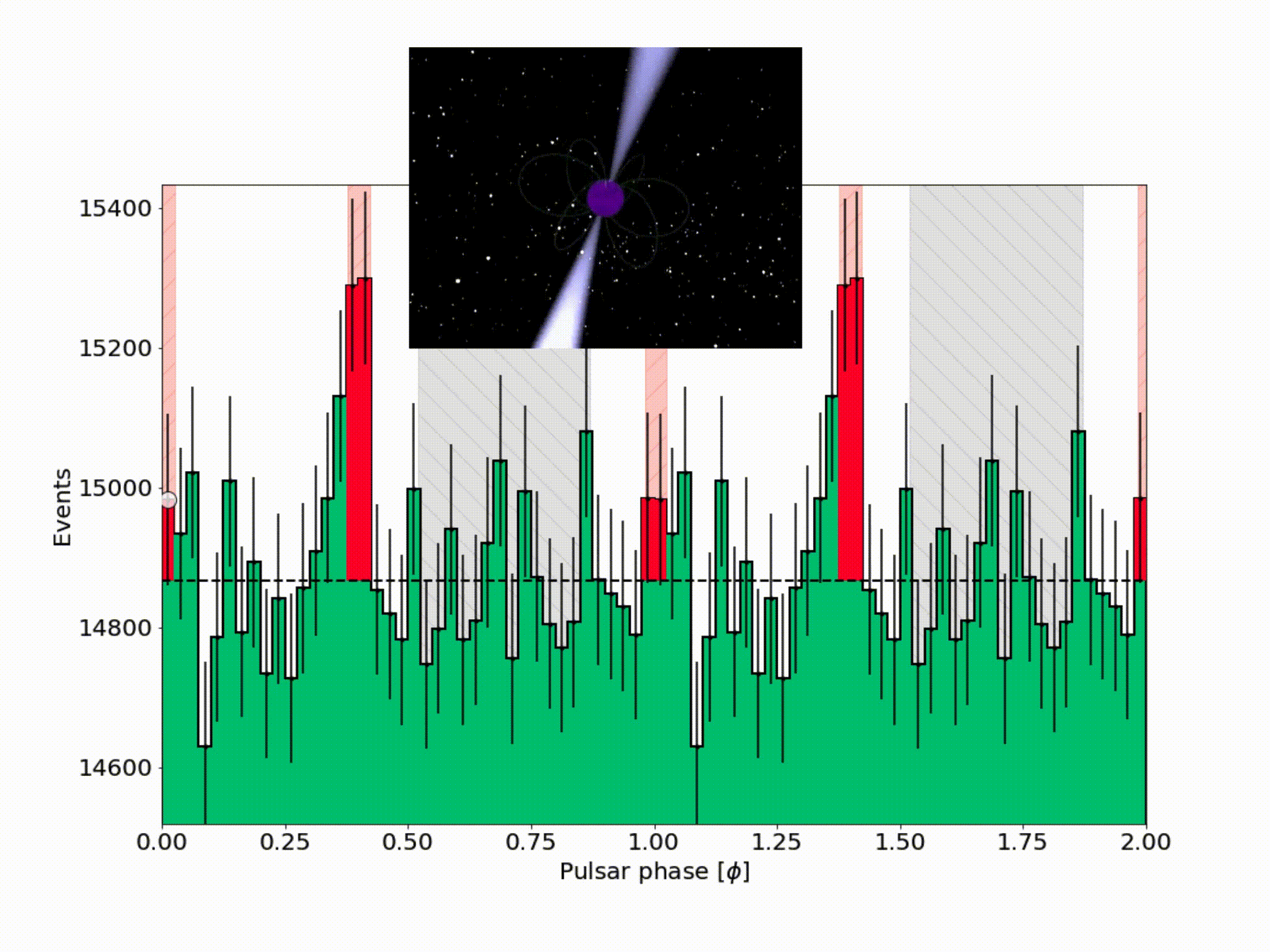Recent News
Northern Hemisphere Array Begins to Take Shape with Installation of LST-4 Dish Structure
Until recently, the prototype of the Large-Sized Telescope (LST), the LST-1, has stood alone on the CTAO's northern hemisphere array site at the Instituto de Astrofísica de Canarias' (IAC's) Roque de los Muchachos Observatory in Villa de Garafía on La Palma, Spain. But, in 2023, the CTAO LST Collaboration began laying the foundations and constructing the three remaining LSTs planned for the site -- the LST-2, LST-3 and LST-4. It was on 3 May that an important milestone was achieved when the 18-tonne mirror dish structure of the LST-4 was successfully lifted onto its lower structure.
|
This intricate operation involved raising the dish to a height of 18 metres above the ground, where it was securely positioned with the assistance of a 200-tonne crane. The installation process presented its challenges, particularly as the large structure must be lifted and installed in a single procedure. However, thanks to the perfect weather conditions and the expertise of contractor MERO-TSK and subcontractor CaSanaTec, the operation was smoothly executed within a few hours. The telescope's elegant mechanical design is a product of a cooperation between MPP Munich, LAPP Annecy, IFAE Barcelona and several industrial partners. The construction and installation contract is being executed largely by the IAC, together with the LST Collaboration members. Concurrently, construction is progressing for the LST-2 and LST-3, alongside the LST-4, with more key milestones planned for each telescope. Construction and assembly of the upcoming LSTs remain on schedule with an expected completion by early 2026. |
The LSTs are procured and constructed by the LST Collaboration for the CTAO. The LST-1 was inaugurated in 2018 and is completing its commissioning and is already demonstrating scientific results. The LSTs have a reflective surface of 400 m 2 that collects and focuses the Cherenkov light into the camera, where 1855 state-of-the-art photomultiplier tubes convert the light into electrical signals. Thanks to the large reflective surface, they have an unrivalled collection area that improves sensitivity at the lowest energies. This leads to a significant improvement in sensitivity over the previous generation of IACTs for energies below 50 GeV. Despite their substantial size, weighing approximately 110 tonnes and standing 45 metres tall, the LSTs boast impressive manoeuvrability. Recent tests conducted with the LST-1 in February by MPP, IFAE, and LAPP confirm their capability to swiftly position to any point in the sky in less than 30 seconds, facilitating the capture of transient, low-energy gamma-ray signals.
In addition to the four LSTs on the CTAO's northern site, an enhancement plan funded by the Italian Resilience and Recovery Plan (PNRR), which was proposed by INAF and INFN, includes the implementation of two LSTs for the CTAO's southern hemisphere array in Paranal, Chile. More news from the LST Collaboration and the progress of both sites are still to come, so stay tuned for further updates.
Recent Scientific Highlights
LST-1 Discovers the Most Distant AGN at Very High Energies
26 December 2023
La Palma, Spain - On 15 December, the Large-Sized Telescope (LST) Collaboration announced through an Astronomer’s Telegram (ATel) the detection of the source OP 313 at very high energies with the LST-1. Although OP 313 was known at lower energies, it had never been detected above 100 GeV, making this the LST-1’s first scientific discovery. With these results, OP 313 becomes the most distant Active Galactic Nuclei (AGN) ever detected by a Cherenkov telescope, further showcasing the LST prototype’s exceptional performance while it is being commissioned on the CTAO-North site on the island of La Palma, Spain.

OP 313 is what is known as a Flat Spectrum Radio Quasar or FSRQ, a type of AGN. These are very luminous objects found in the centres of some galaxies, where a supermassive black hole devours material from its surroundings, creating powerful accretion disks and jets of light and relativistic particles.
The LST-1 observed this source between December 10 and 14, after receiving an alert from the Fermi-LAT satellite that showed unusually high activity in the low-energy gamma-ray regime, confirmed also in the optical range with different instruments. With just four days of data, the LST Collaboration was able to detect the source above 100 Gigaelectronvolts (GeV), an energy level a billion times higher than the visible light humans can perceive.
Only nine quasars are known at very high energies, and OP 313 is now the tenth. In general, quasars are more difficult to detect at very high energies than other types of AGN. This is not only because the brightness of their accretion disk weakens the emission of gamma rays, but because they are further away. In this case, OP 313 is located at a redshift of 0.997 or ~8 billion light years away, making it the most distant AGN and the second most distant source ever detected at very high energies.
The more distant the source, the more difficult it is to observe at very high energies due to the so-called Extragalactic Background Light or EBL. The EBL is the collective light emitted by all objects outside the Milky Way that expands across multiple wavelengths, from visible, infrared and ultraviolet. The EBL interacts with very high-energy gamma rays, attenuating their flux and, thus, making their observation challenging. The characteristics of the LST-1, with an optimized sensitivity for the CTAO's low energy range, between 20 and 150 GeV, where gamma rays are less affected by the EBL, enabled the LST Collaboration to extend the study of this source to tens of GeV for the first time.
The LST Collaboration will continue to observe this source with the LST-1 to expand the dataset and, thus, obtain a more precise analysis that allows scientists to improve their understanding of the EBL, study the magnetic fields within this type of source or delve into fundamental intergalactic physics.
>> Read and Download the Press Release in English.
>> Lee y Descarga la Nota de Prensa en Español.
LST-1 Detects Very High-Energy Emission from the Crab Pulsar
22 June 2020
Between January and February 2020, the prototype Large-Sized Telescope (LST), the LST-1, observed the Crab Pulsar, the rapidly rotating neutron star at the centre of the Crab Nebula. The telescope, which is being commissioned on the CTA-North site on the island of La Palma in the Canary Islands, was conducting engineering runs to verify the telescope performance.
Pulsars are very rapidly rotating and strongly magnetized neutron stars that emit light in the form of two beams, which can be observed from Earth only when passing our line of sight. While detecting the strong and steady emission or outbursts of gamma-ray sources with Imaging Atmospheric Cherenkov Telescopes (IACTs) has become routine, pulsars are much more challenging to detect due to their weak signals and the typical dominance of the foreground gamma-ray signal from the surrounding nebulae. Despite hundreds of observations hours by IACTs around the globe, only four pulsars emitting signals in the very high-energy gamma-ray regime have been discovered, so far. Now that the LST-1 has shown that it can detect the Crab pulsar, it joins the field of telescopes capable of detecting gamma-ray pulsars, validating the timestamping system and the low-energy performance of the telescope.

“This milestone shows us that the LST-1 is already performing at an extraordinary level, detecting a challenging source in record time,” says Masahiro Teshima, Director of Max-Planck-Institute for physics in Munich and Principal Investigator of LST. “Pulsars are one of the key scientific targets of the LSTs, and it’s exciting to imagine what we’ll be able to achieve when the telescope is fully commissioned and operational.”

The data set collected includes 11.4 hours from eight observation nights. Figure 1 shows the resulting phasogram, plotting the gamma-ray events as a function of the pulsar rotation phase. In the phase regions marked as P1 and P2, more gamma rays are expected as the Crab pulsar emits towards the Earth. The emission detected in all phases (marked green in Figure 1) is a mixture of different background contributions, including the irreducible steady emission from the Crab Nebula. The signal detected with the LST-1 (marked red in Figure 1) is undeniably significant for phase P2, while the signal during P1 is still marginal. The animation in Figure 2 highlights the pulse behaviour of the source during the different phases.
Further information about the Crab Pulsar detection can be found below:
CTA Prototype LST-1 Detects Very High-Energy Emission from the Crab Pulsar
IAC Statement on Volcanic Eruption:
https://www.iac.es/en/outreach/news/iac-statement-volcanic-eruption-la-palma-0
24 September 2021
The Instituto de Astrofísica de Canarias wants to extend its solidarity and support to the island of La Palma, to all who are suffering the consequences of the volcanic eruption, and especially to those who had to abandon their homes or have suffered damages to their properties. We share the pain that this has caused them and the wish for the circumstances to change for the better as soon as possible. The authorities and all the institutions involved in the emergency plan have the material and staff resources of the IAC at their disposal for whatever they consider necessary.
The Roque de los Muchachos Observatory, which remains operational, monitors continuously the cloud caused by the volcanic eruption and various indicators of atmospheric properties. The data are available to the scientific community in charge of monitoring the evolution of the volcano.
Due to the presence of ash in the air, telescope operations were shut down on Thursday, September 23, to protect the telescopes' optical systems. However, the ash level is low, and no health risk has been identified, so technical operations continue at the observatory, following at all times the safety measures indicated by the authorities managing the emergency.
The congress "Dark and Quiet Skies for Science and Society II", organised by the IAC, United Nations and the International Astronomical Union, with the collaboration of the institutions of La Palma, and which was to take place on the island between October 3 and 8, will finally be held exclusively online. The organising committee of the congress has been following the evolution of the situation in La Palma closely and, although its initial intention was to go on with the on-site celebration as a show of support for the island, it has taken this decision given the growing need for resources for the island itself. Our primary concern as an institution is that all efforts should now focus on meeting the needs of the island's population and on managing the emergency.
We are deeply grateful for the extraordinary work and continued efforts of all those involved in the operation to assist those affected by this eruption and the continued support provided by the island's authorities to mitigate the situation. We wish them all much strength and courage to face the difficult times we are going through.
We encourage the numerous followers and friends of the IAC and all those who have contacted us asking how they can help the people of La Palma to make their donations in support of the island through the following channels provided by various public administrations:
- Cabildo de La Palma:
People who want to donate Bizum must access the 'Send donation' tab and enter the code 03747. In this case, the maximum amount of total daily contributions per person is 2,000 euros, which can be paid in various operations, with a limit of 500 euros per transaction.
The bank account number authorised to formalise national donations through bank transfer is ES47 2100 9169 0122 0017 9456; for international donations, it is CAIXESBBXXX.
When donating, 'Donación volcán' should be indicated in the payment description. If you want to record your help, you can register your NIF/DNI number and business name or name and surname.
More information: https://www.cabildodelapalma.es/es/como-ayudar-afectados-volcan-de-la-palma
- Los Llanos de Aridane City Council:
People who want to donate through Bizum must access the 'Send donation' tab and enter the code 03749.
Account: ES06 2100 1921 1902 0014 1752
- Name of the issuer
- Payment description: 'Donación volcán La Palma'
- Recipient: Ayuntamiento de Los Llanos de Aridane
- El Paso City Council:
People who want to donate through Bizum must access the 'Send donation' tab and enter the code 03748 (La Caixa) or the code 03776 (Cajasiete).
Accounts to formalize national donations through bank transfer:
- ES26 2100 7109 3122 0015 5652 (La Caixa)
- ES57 3076 0480 6710 0761 6723 (Cajasiete)
- Indicate DNI, name and surname. Payment description: Aportación Erupción volcánica
For international contributions, the codes are BIC LA CAIXA: CAIXESBBXXX and BIC CAJASIETE: BCOEESMM076.